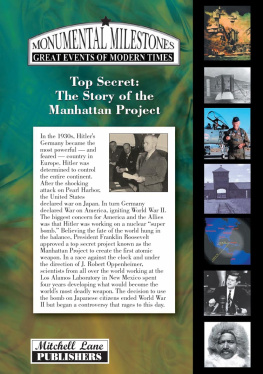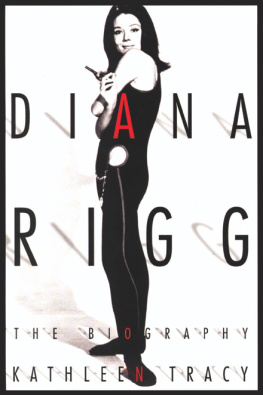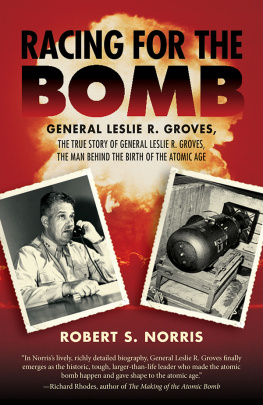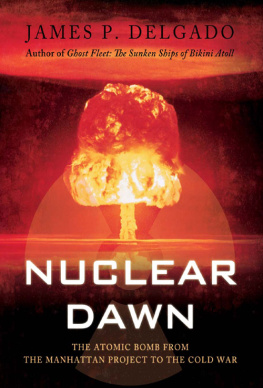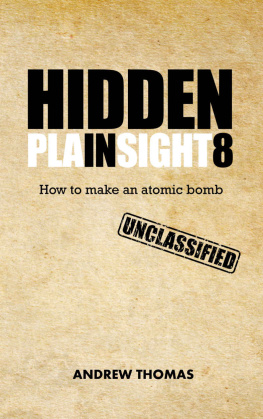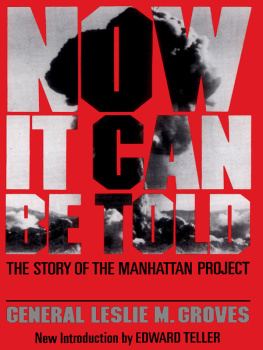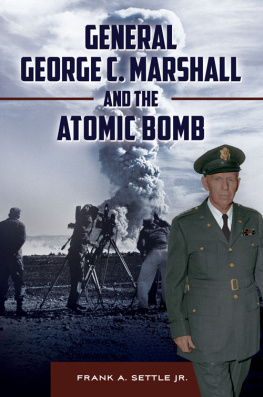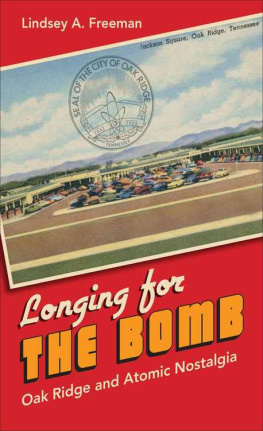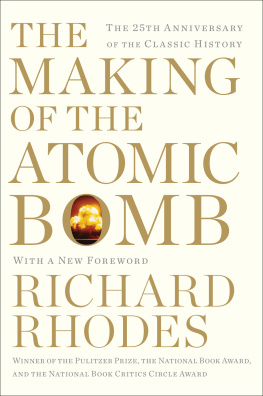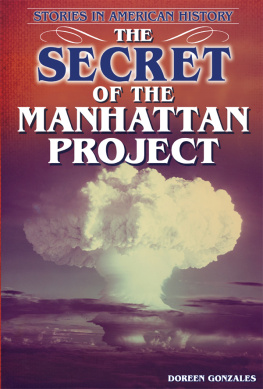Kathleen Tracy - Top Secret: The Story of the Manhattan Project
Here you can read online Kathleen Tracy - Top Secret: The Story of the Manhattan Project full text of the book (entire story) in english for free. Download pdf and epub, get meaning, cover and reviews about this ebook. year: 2020, publisher: Mitchell Lane, genre: Politics. Description of the work, (preface) as well as reviews are available. Best literature library LitArk.com created for fans of good reading and offers a wide selection of genres:
Romance novel
Science fiction
Adventure
Detective
Science
History
Home and family
Prose
Art
Politics
Computer
Non-fiction
Religion
Business
Children
Humor
Choose a favorite category and find really read worthwhile books. Enjoy immersion in the world of imagination, feel the emotions of the characters or learn something new for yourself, make an fascinating discovery.
- Book:Top Secret: The Story of the Manhattan Project
- Author:
- Publisher:Mitchell Lane
- Genre:
- Year:2020
- Rating:3 / 5
- Favourites:Add to favourites
- Your mark:
- 60
- 1
- 2
- 3
- 4
- 5
Top Secret: The Story of the Manhattan Project: summary, description and annotation
We offer to read an annotation, description, summary or preface (depends on what the author of the book "Top Secret: The Story of the Manhattan Project" wrote himself). If you haven't found the necessary information about the book — write in the comments, we will try to find it.
Describes the events and people involved in the making of the atomic bomb.
Top Secret: The Story of the Manhattan Project — read online for free the complete book (whole text) full work
Below is the text of the book, divided by pages. System saving the place of the last page read, allows you to conveniently read the book "Top Secret: The Story of the Manhattan Project" online for free, without having to search again every time where you left off. Put a bookmark, and you can go to the page where you finished reading at any time.
Font size:
Interval:
Bookmark:


Titles in the Series
The Assassination of John F. Kennedy, 1963
Blitzkrieg! Hitlers Lightning War
Breaking the Sound Barrier:
The Story of Chuck Yeager
The Civil Rights Movement
The Creation of Israel
The Cuban Missile Crisis:
The Cold War Goes Hot
The Dawn of Aviation:
The Story of the Wright Brothers
Disaster in the Indian Ocean:
Tsunami, 2004
Exploring the North Pole:
The Story of Robert Edwin Peary and Matthew Henson
The Fall of the Berlin Wall
The Fall of the Soviet Union, 1991
Hurricane Katrina and
the Devastation of New Orleans, 2005
An Overview of World War I
The Russian Revolution, 1917
The Scopes Monkey Trial
The Sinking of the Titanic
The Story of the Attack on Pearl Harbor
The Story of the Great Depression
The Story of the Holocaust
Top Secret: The Story of the Manhattan Project
The Vietnam War
The Watergate Scandal

Copyright 2006 by Mitchell Lane Publishers, Inc. All rights reserved. No part of this book may be reproduced without written permission from the publisher. Printed and bound in the United States of America.
Printing 2 3 4 5 6 7 8
Library of Congress Cataloging-in-Publication Data
Tracy, Kathleen.
Top secret: the story of the Manhattan Project / by Kathleen Tracy.
p. cm. (Monumental milestones: great events of modern times)
Includes bibliographical references and index.
ISBN 1-58415-399-7 (lib. bd.)
1. Manhattan Project (U.S.)Juvenile literature. 2. Atomic bombUnited StatesHistoryJuvenile literature. I. Title. II. Monumental milestones.
QC773.3.U5T73 2005
355.8251190973dc22
2004030310
ISBN-13: 9781584153993
eISBN-13: 9781545749487
ABOUT THE AUTHOR: Kathleen Tracy has been a journalist for over twenty years. Her writing has been featured in magazines including The Toronto Stars Star Week, A&E Biography magazine, KidScreen, and TVTimes. She is also the author of numerous biographies including The Boy Who Would be King (Dutton), Jerry SeinfeldThe Entire Domain (Carol Publishing), Don ImusAmericas Cowboy (Carroll & Graf), Mariano Guadalupe Vallejo, and William Hewlett: Pioneer of the Computer Age, both for Mitchell Lane. She has also completed Diana Rigg: The Biography for Benbella Books.
PHOTO CREDITS: Cover, pp. 1, 3 Getty Images; p. 6 Library of Congress; p. 13 Science Researchers, p. 15 Corbis; p. 20 Getty Images; p. 25 National Archives at College Park, Maryland; p. 28 Library of Congress; p. 36 Getty Images.
PUBLISHERS NOTE: This story is based on the authors extensive research, which she believes to be accurate. Documentation of such research is contained on page 46.
The internet sites referenced herein were active as of the publication date. Due to the fleeting nature of some web sites, we cannot guarantee they will all be active when you are reading this book.
PLB2,4
Contents
Top Secret:
The Story of the Manhattan Project
Kathleen Tracy

CHAPTER
A Day of Infamy
December 7, 1941 started out as a quiet Sunday morning on the Hawaiian island of Oahu. Docked at Pearl Harbor were 130 battleships, cruisers and destroyers, about half of the United States Navys Pacific Fleet. Seven of the nine battleships were moored along what was called Battleship Row on the shore of Ford Island. Nearby was a Naval air station where hundreds of U.S. warplanes were parked.
Shortly before 7:00 A.M., the crew of the destroyer U.S.S. Ward had spotted a mini Japanese submarine trying to make its way into the harbor. They dropped depth charges which sunk the sub. They reported the incident to headquarters. A few minutes later, a radar station picked up signals indicating a large number of airplanes. But the controllers assumed it was the aircraft from an American carrier.
The first hint that the controllers had been terribly wrong was a noise. It began as a hum and then turned into a roar as Japanese planes suddenly appeared in the sky. At 7:53 A.M. the first bombs began to drop on Pearl Harbor. Although caught completely by surprise, the soldiers tried to fight back, manning their guns and trying to protect themselves and the fleet. But because they were tied down, the battleships were particularly vulnerable. About twenty minutes into the attack, a bomb weighing nearly a ton struck the U.S.S. Arizona and caused a massive explosion.
Marine Corporal E.C. Nightingale was one of the few survivors of the Arizona. According to his eyewitness account, I was the last man to leave secondary aftThe railings, as we ascended, were very hot and as we reached the boat deck I noted that it was torn up and burned. The bodies of the dead were thick, and badly burned men were heading for the quarterdeck, only to fall apparently dead or badly wounded.
The Arizona sank in less than nine minutes, killing more than 1,100 sailors.
In addition to the war planes, the Japanese had sent several mini subs to the harbor. The U.S.S. Oklahoma was hit by several torpedoes and rolled over in the water, trapping more than 400 men inside. Both the U.S.S. California and U.S.S. West Virginia were sunk. The U.S.S. Utah capsized with more than 50 men on board. The U.S.S. Maryland, U.S.S. Pennsylvania, and U.S.S. Tennessee all suffered significant damage.
A second wave of warplanes struck after 8:30 A.M. and would last almost an hour. This time the attacks continued to pound the ships in the harbor, destroying the U.S.S. Shaw and the U.S.S. Sotoyomo. The U.S.S. Nevada tried to make it to sea but suffered too much damage and was beached to prevent it from sinking. In addition to targeting the ships, the Japanese fighters also attacked the nearby air fields.
Finally, shortly before 10:00 A.M., it was over. The Japanese flew away leaving Pearl Harbor a scene of horror and chaos. In all, 2,403 Americans were killed, 188 planes and eight battleships were either destroyed or badly damaged. The Japanese had lost twenty-nine aircraft and five midget subs. Despite the horrible loss of life and destruction, the attack had not completely taken out the Pacific Fleet. All the aircraft carriers had been out to sea, the submarines had survived virtually intact and Pearl Harbor itself was still usable. Even so, the attack crippled the U.S. Navys capability for the immediate future. It also gave America no choice but to declare war on Japan.
The attack on Pearl Harbor was the result of long-brewing tensions. In 1931, Japan had invaded the Chinese province of Manchuria over the protests of the United States. Later in the decade, Japan joined the dictator Adolf Hitlers Nazi Germany and the dictator Benito Mussolinis Italy in what was called the Axis Alliance.
America tried to solve its differences with Japan diplomatically and through economic pressure, such as refusing to sell Japans oil. But the Japanese leadership resisted and saw the embargoes as a direct threat. Rather than give in, Japan had made plans to go to war with America. But instead of officially declaring war, they started the conflict with the surprise attack on Pearl Harbor.
Next pageFont size:
Interval:
Bookmark:
Similar books «Top Secret: The Story of the Manhattan Project»
Look at similar books to Top Secret: The Story of the Manhattan Project. We have selected literature similar in name and meaning in the hope of providing readers with more options to find new, interesting, not yet read works.
Discussion, reviews of the book Top Secret: The Story of the Manhattan Project and just readers' own opinions. Leave your comments, write what you think about the work, its meaning or the main characters. Specify what exactly you liked and what you didn't like, and why you think so.

